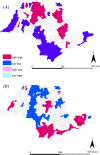Clusters of preterm live births and respiratory distress syndrome-associated neonatal deaths: spatial distribution and cooccurrence patterns
- PMID: 35725459
- PMCID: PMC9210662
- DOI: 10.1186/s12889-022-13629-4
Clusters of preterm live births and respiratory distress syndrome-associated neonatal deaths: spatial distribution and cooccurrence patterns
Abstract
Background: Prematurity and respiratory distress syndrome (RDS) are strongly associated. RDS continues to be an important contributor to neonatal mortality in low- and middle-income countries. This study aimed to identify clusters of preterm live births and RDS-associated neonatal deaths, and their cooccurrence pattern in São Paulo State, Brazil, between 2004 and 2015. METHODS: Population-based study of all live births with gestational age ≥ 22 weeks, birthweight ≥ 400 g, without congenital anomalies from mothers living in São Paulo State, Brazil, during 2004-2015. RDS-associated neonatal mortality was defined as deaths < 28 days with ICD-10 codes P22.0 or P28.0. RDS-associated neonatal mortality and preterm live births rates per municipality were submitted to first- and second-order spatial analysis before and after smoothing using local Bayes estimates. Spearman test was applied to identify the correlation pattern between both rates.
Results: Six hundred forty-five thousand two hundred seventy-six preterm live births and 11,078 RDS-associated neonatal deaths in São Paulo State, Brazil, during the study period were analyzed. After smoothing, a non-random spatial distribution of preterm live births rate (I = 0.78; p = 0.001) and RDS-associated neonatal mortality rate (I = 0.73; p = 0.001) was identified. LISA maps confirmed clusters for both, with a negative correlation (r = -0.24; p = 0.0000). Clusters of high RDS-associated neonatal mortality rates overlapping with clusters of low preterm live births rates were detected.
Conclusions: Asymmetric cluster distribution of preterm live births and RDS-associated neonatal deaths may be helpful to indicate areas for perinatal healthcare improvement.
Keywords: Epidemiological Studies; Infant; Neonatal Mortality; Newborn; Population; Premature; Respiratory Distress Syndrome; Spatial Distribution.
© 2022. The Author(s).
Conflict of interest statement
The authors declare that they have no competing interests. Database use was possible due to FAPESP (Project # 2017/03748–7) and due to agreements #23089.004297/2008–11 and #23089.000057/2014–95 between Fundação SEADE and Universidade Federal de São Paulo.
Figures





References
-
- Muhe LM, McClure EM, Nigussie AK, Mekasha A, Worku B, Worku A, et al. Major causes of death in preterm infants in selected hospitals in Ethiopia (SIP): a prospective, cross-sectional, observational study. Lancet Glob Health. 2019;7(8):e1130–e1138. doi: 10.1016/S2214-109X(19)30220-7. - DOI - PMC - PubMed
Publication types
MeSH terms
LinkOut - more resources
Full Text Sources

